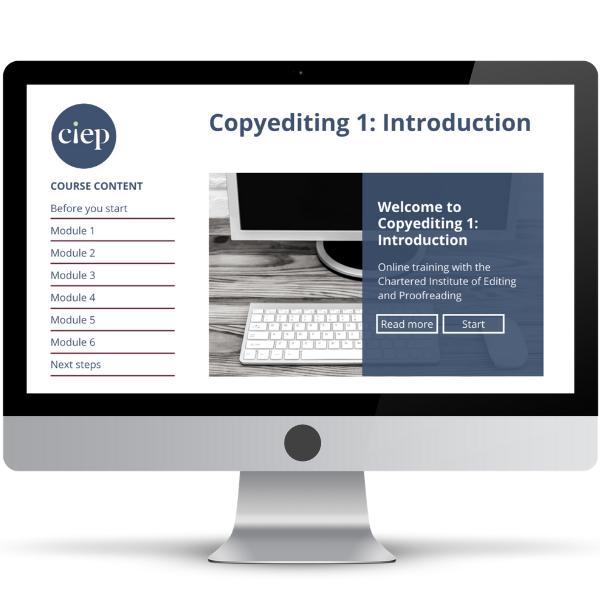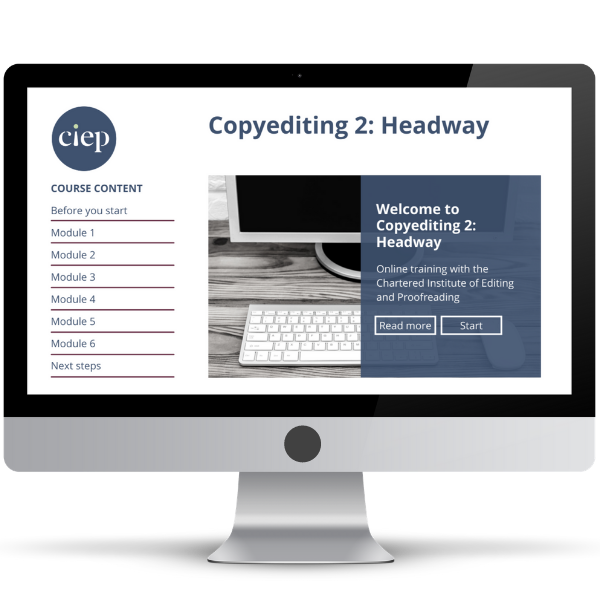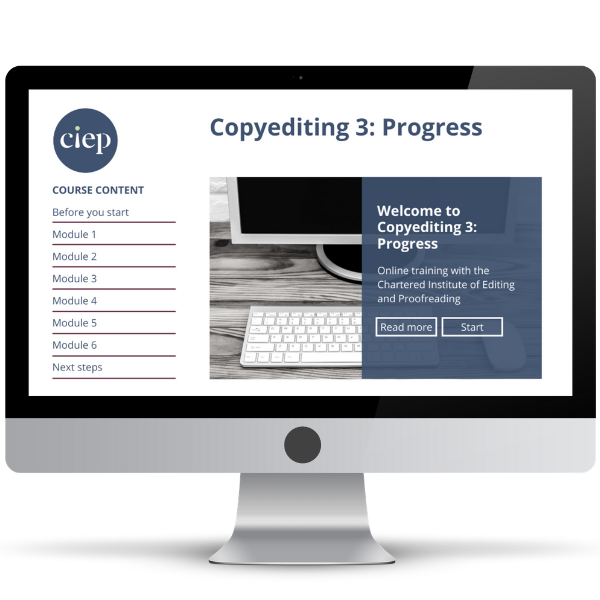What is copyediting?
Copyediting's place in publishing
‘Copy’ is another word for text that is to be published, from a company report to a book to product packaging (or anything else with words).
In the traditional publishing workflow, copyediting comes after developmental and stylistic line editing, and involves:
- agreeing final content
- checking grammar, spelling and punctuation
- applying consistency to the language and formatting
- making sure it’s clear and reads well for its intended purpose.
Once a text has been copyedited, it’s ready for design and layout, and then proofreading.
Who do copyeditors work with?
Copyeditors work with readers, authors, publishers and designers/typesetters.
Helping the reader
A copyeditor helps the reader by, for example:
- making the structure of the document as clear as possible, including signposting elements like headings, notes, illustrations, references and glossary
- making the language appropriate and understandable for the likely reader, with vocabulary choice, grammar and punctuation that bring clarity.
Helping the author
A copyeditor helps the author by, for example:
- ensuring their message is clear and achieves its purpose
- correcting or querying anything that seems to be an error, including misspelled names, misused words, numbers that don’t add up, incomplete references and inconsistent arguments
- suggesting ways to reduce the length of a text, use the available space better or integrate new material most effectively.
Helping the publisher
A copyeditor helps the publisher by, for example:
- getting the text into fit shape to go to the next stage of the publishing workflow
- highlighting possible legal issues such as plagiarism or breach of copyright, libel, obscenity or actionable discrimination.
Helping the designer
A copyeditor helps the designer or typesetter by, for example:
- providing a clean text document that can be formatted or imported into design software to prepare the final output
- marking up the document structure and elements like special characters and illustrations so that the designer knows where they go.
Learn how to copyedit
Learn how to be a professional copyeditor with our suite of online training courses that take you from beginner to ready for market.
Understanding house style
Many changes at copyediting stage are made for consistency, either within the document or publication or to comply with a client’s style guide.
Our short guide Your House Style explains how to create a style guide.
What does copyediting involve?
The tasks carried out during copyediting will vary depending on the nature of the text, how and where it will be published, what work has or will be carried out by someone else, and practical considerations such as the budget and time available.
Here are some typical copyediting tasks.
Checking
Checking that all elements of a text or document are present, in the right order and are referred to in the same way throughout. For example:
- Checking that any references to content or features elsewhere in the text (cross-references) are accurate.
- Checking that basic facts and arguments are plausible, consistent and reasonable.
- Querying any language that is non-inclusive or problematic from a legal point of view.
- In fiction, checking that characters’ physical characteristics and names stay the same, and that the timeline and the fictional world hold together, and keeping the narrative voice consistent.
Correcting and consistency checking
- Correcting errors or inconsistencies in spelling, punctuation, grammar, style and usage.
- Checking and correcting spellings of names, for example of places or people.
- Imposing consistency in use of, for example, italics, bold and capitals.
- Improving clarity by rewording or reformatting text that is confusing or convoluted, or suggesting structural additions to help readability such as headings or lists.
Cleaning
- Cleaning up the document before it goes for design/layout (for example by removing unwanted formatting and extra spaces).
- Marking up the structure of the document (such as heading levels, boxed items, lists, figures and images).
Communicating
- Creating and populating information documents (such as a style sheet and instructions for the designer/typesetter).
- Liaising with the author or intermediary on anything that the copyeditor cannot confirm alone, such as preferred points of style, approval of suggested rewording or the location of missing information.
How do copyeditors work?
In Word
Copyeditors usually mark up edits in a Word document using Track Changes. After an agreed process of feedback from the client and revision, they produce a final edited version of the text.
On hard copy
Less commonly these days, the client may want the edits marked on a printout (hard copy), in which case someone other than the editor will need to make the corrections to the final document.
In other software
Sometimes copyeditors work directly on the layout itself, in software such as InDesign, PowerPoint, a content management system or a web editor.
Once the copyeditor’s changes have been made and checked, the text should be ready to send to a designer or typesetter.
Who’s responsible?
While a professional copyeditor will always aim for the highest standards, any remaining errors are ultimately the responsibility of the publisher.Will a copyeditor make your text perfect?
No professional copyeditor should promise to make your text perfect.
No matter how well trained, experienced and diligent they are, they are still human.
Furthermore, perfection is a subjective concept. While some errors are indisputable, others aren’t. At copyediting stage, many changes are made simply for consistency or based on style preferences.
Is there an acceptable rate of errors for copyediting?
Even though copyeditors can’t make text perfect, it’s important that they work to a high standard.
Some people will assert that copyeditors should catch a certain percentage of errors, but we don’t believe this is helpful because:
- some errors are subjective in nature
- the copyeditor will be working within other constraints such as budget and schedule.
We recommend thinking in terms of whether the copyeditor has made the text fit for purpose within the limits of their brief. There should be consistency and clarity, and no barriers to the reader understanding the meaning of the text.
Upholding copyediting standards
The CIEP is committed to upholding and promoting high editorial standards, which is why all our members formally agree to abide by our Professional Practice Code.
We also have a formal procedure for complaints and appeals on the rare occasion we receive them.
How long does copyediting take?
Complexity factors
How complex, difficult or badly written the draft text is determines the pace at which a copyeditor can work.
Unless the material is straightforward, the copyeditor will probably need to go through it several times to cover different elements such as structure, stylistic consistency, cross-references and meaning.
Efficiency factors
A copyeditor cannot work for hours at a time and remain efficient. It also takes time to get up to speed, reading or rereading the brief and style guide, so short jobs are proportionately slower.
Estimated speeds
With the caveat that each job is different and must be assessed on its own factors, an experienced professional may copyedit around 1,000 to 3,000 words per hour on a typically straightforward text.
If the text needs heavy editing or rewriting, the rate may be much slower.
If the budget or schedule is too tight, the concept of ‘good enough’ may need to be adjusted accordingly and agreed with the client. In that case, the copyeditor will minimise and simplify any changes, or agree with the client which tasks to omit.
How should I brief a copyeditor?
Make sure the copyeditor understands your needs, so they can meet your expectations.
You can find guidance in our free booklet Proofreading or editing? A quick guide to using editorial professionals.



